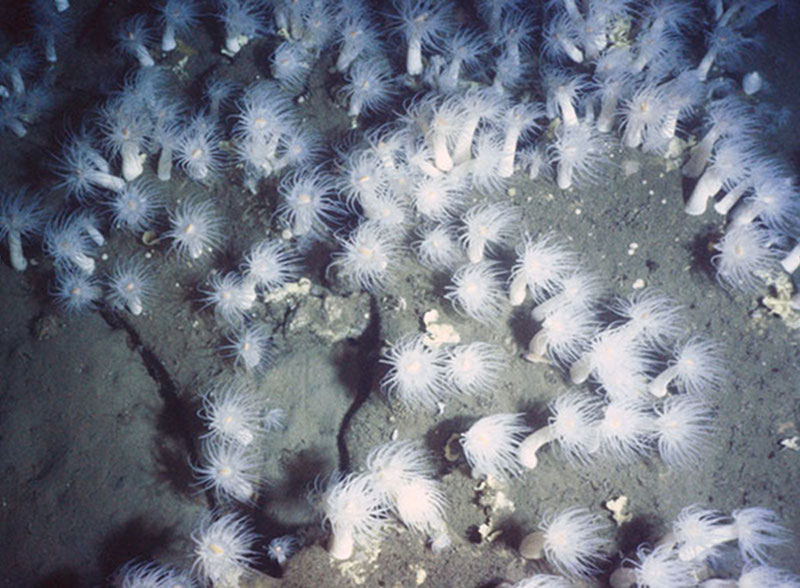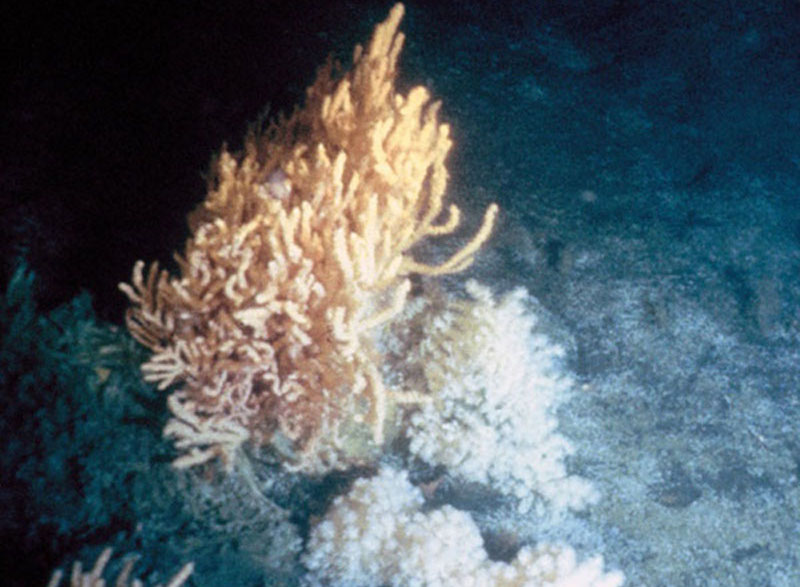

Large colonies of the gorgonian Paragorgia, commonly called the ‘bubblegum coral’ on the wall of Baltimore canyon. These colonies may be white, pink, red or purple and can be over 1 m tall. Image courtesy of Barbara Hecker, Hecker Consulting. Download image (jpg, 71 KB).
Hard rocky habitats in areas of high current are often colonized by sessile benthic animals such as corals and sponges; this is true everywhere, from the shallow coastal areas to the deep sea. In some locations these benthic hardbottom communities are dense, diverse and ecologically important as habitat, feeding and breeding grounds for a wide variety of invertebrates and fishes. In the deep sea, animals tend to grow more slowly and live longer than in shallow warm water, and deep-water corals are some of the oldest animals on earth; for example, a black coral tree from Hawaii was recently determined to be over 4,000 years old. Their slow growth, longevity and diverse community structure make deep-water coral ecosystems sensitive to damage as they would take a very long time to recover.
The distribution of deep-water corals along the slopes and canyons of northeastern US is poorly understood, in contrast to the adjacent Canadian and southeastern US regions. Available information indicates that the mid Atlantic canyon corals are dominated by octocorals, solitary cup corals, and anemones, rather than the large concentrations of reef-forming stony corals that dominate areas to the south. Rich communities of corals were observed on the steep walls of canyons off the northeastern US; however, the distribution of these communities was patchy rather than continuous. Suitable conditions for coral community development are limited within most canyons, with the majority of benthic habitat being soft sediment or compacted clays.

Fields of white anemones are often seen on low relief rocky pavements in Baltimore and Norfolk canyon. Image courtesy of Barbara Hecker, Hecker Consulting. Download image (jpg, 122 KB).

Gorgonians are diverse and locally abundant on rocky outcroppings within the canyons. Image courtesy of Barbara Hecker, Hecker Consulting. Download image (jpg, 96 KB).
One of the primary objectives of the mid Atlantic canyons project is to locate and describe areas of deep-water coral habitat. We will use the ROV video and digital images to describe the distribution and habitat association of different coral species, as well as community structure and environmental conditions of coral-dominated areas. We will supplement the visual data with collections of coral specimens that will be used to study their taxonomy, genetic structure and phylogeny, reproductive biology, food supply, age and growth. We will also use ‘predictive habitat modeling’ to identify other locations where corals might occur; this technique combines biological, oceanographic and geological data that we will collect during the project, to identify all those locations in the canyons where corals may occur. This can be a very useful tool as we can only survey very small areas during our research cruises, and if appropriately constructed predictive models can help regulatory agencies define areas where human activities should be restricted.